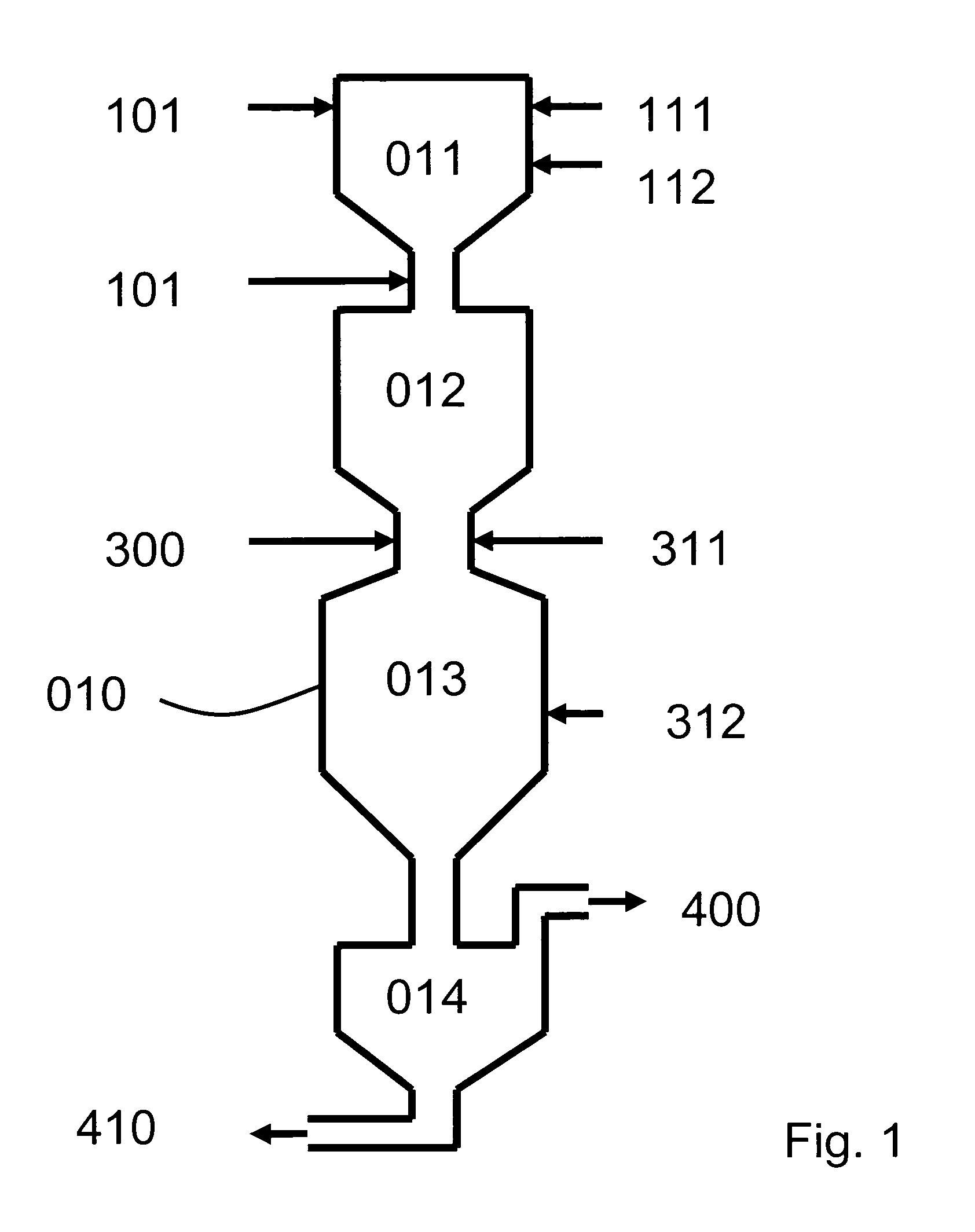Process for the Production of Ethylene
- Summary
- Abstract
- Description
- Claims
- Application Information
AI Technical Summary
Benefits of technology
Problems solved by technology
Method used
Image
Examples
example 1
[0051]These experiments show the main reaction between acetylene and an alkane feed such as ethane at a reaction temperature between 880° C. and 890° C. The conversion of acetylene was higher than 90%, while the conversion of ethane was higher than 75%. Additional hydrogen used to hydrogenate the acetylene evidently came from the free hydrogen available in the feed. This is quite different from the experiments in Example 2, wherein no ethane was added to the feed.
[0052]The flow rate of the feed was controlled to have a constant time. For a typical case when ethane was added to a pyrolysis product gas containing syngas, acetylene and water a feed comprising 8.6% C2H2, 4.4% C2H6, 5.5% N2, 13% CO, 68.5% H2 and water (at 0.06 cc / min) was tested. The observed results from the hydrogen transfer reaction are shown in Table 1.
TABLE 1Temperature (° C.)880890C2H2 / C2H6 mole ratio1.951.95C2H2 conversion (%)90.092.2C2H6 conversion (%)75.377.2Total C2H4 selectivity (%)63.560.7Outlet C2H2 concentr...
example 2
[0054]To demonstrate the effect of ethane addition to the in-situ hydrogenation reaction a separate experiment was conducted, wherein acetylene hydrogenation in absence of alkane feed is compared to the effect of switching the feed with ethane present in the same experiment. A contact time of 0.44 seconds was maintained. As can be seen with ethane present in the feed the formation of ethylene in column one is more than three times higher than its concentration with no ethane in the feed.
[0055]Table 2 also shows the full outlet composition: some higher hydrocarbons were formed as byproducts of the hydrogenation step in the outlet gas. Only little traceable carbon is observed in the particular hydrogenation step after many days on stream.
TABLE 2Temperature(° C.)C2H4C2H2C2H6N2H2C3H6C4H8C6H6CH4With ethaneFeed——8.817.236.037.2Run85812.752.133.4737.141.40.070.310.472.19Without ethaneFeed——13.7—43.942.5Run8553.974.530.3048.041.5—0.200.430.86
example 3
[0056]This series of experiments were carried out at different temperatures, with contact time for the hydrogenation reaction kept constant. A gas mixture of 8.79 mol % C2H2, 4 mol % N2, 83.9 mol % H2, and 3.05 mol % C2H6 was used with a flow rate 107 cc / min and with water flow 0.06 cc / min. The pressure in the reactor was atmospheric.
[0057]From the results shown in Table 3 it can be concluded that conditions can be optimized, to maximize the ethylene concentration in the outlet.
[0058]The main reaction product was ethylene, small amounts of CH4, C3H6, C4H8 and benzene were found as byproducts. Some byproducts such as alkenes and benzene are considered recoverable valuable byproducts.
TABLE 3Temperature (° C.)855870901915932C2H6 / C2H2, mole ratio0.340.340.340.340.34C2H2 conversion (%)79.384.188.889.892.9C2H6 conversion (%)56.165.059.966.764.6Total C2H4 selectivity (%)59.654.559.857.152.0Outlet C2H2 concentration (%)2.11.671.141.050.74Outlet C2H6 concentration (%)1.541.241.421.191.29Outl...
PUM
| Property | Measurement | Unit |
|---|---|---|
| Temperature | aaaaa | aaaaa |
| Temperature | aaaaa | aaaaa |
| Temperature | aaaaa | aaaaa |
Abstract
Description
Claims
Application Information
 Login to View More
Login to View More - R&D
- Intellectual Property
- Life Sciences
- Materials
- Tech Scout
- Unparalleled Data Quality
- Higher Quality Content
- 60% Fewer Hallucinations
Browse by: Latest US Patents, China's latest patents, Technical Efficacy Thesaurus, Application Domain, Technology Topic, Popular Technical Reports.
© 2025 PatSnap. All rights reserved.Legal|Privacy policy|Modern Slavery Act Transparency Statement|Sitemap|About US| Contact US: help@patsnap.com



